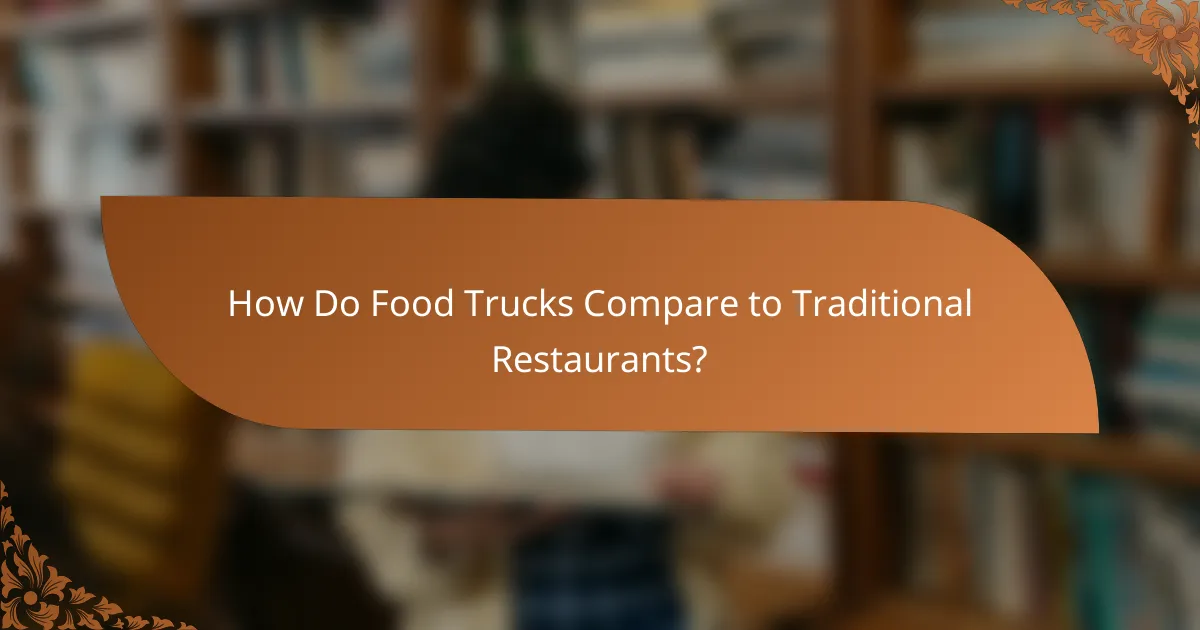Food trucks are transforming urban dining by offering convenient access to a diverse array of cuisines at affordable prices. In 2023, they are embracing trends like plant-based offerings and gourmet street food, enhancing the dining experience while fostering community engagement and social interactions in shared spaces.

How Are Food Trucks Transforming Urban Dining?
Food trucks are revolutionizing urban dining by providing convenient access to a wide variety of cuisines, often at lower prices than traditional restaurants. They enhance the dining experience by bringing diverse culinary options directly to neighborhoods and public spaces.
Increased accessibility to diverse cuisines
Food trucks offer a unique opportunity to experience global flavors without the need for extensive travel. They often feature menus inspired by various cultures, allowing diners to sample everything from gourmet tacos to authentic Indian curries in a single city block.
Many food trucks rotate locations, making it easier for communities to access different types of cuisine regularly. This mobility not only introduces new tastes but also fosters a sense of culinary adventure among urban dwellers.
Affordable dining options for all
Food trucks generally provide more budget-friendly options compared to traditional restaurants, with many meals priced between $5 and $15. This affordability makes it possible for a wider range of people to enjoy quality meals without breaking the bank.
Additionally, food trucks often have lower overhead costs, allowing them to pass savings onto customers. This pricing strategy attracts a diverse clientele, from students to families, making dining out accessible to more individuals.
Support for local economies
Food trucks contribute significantly to local economies by creating jobs and supporting small businesses. Many food truck owners source ingredients from local farmers and suppliers, which helps keep money within the community.
Moreover, food trucks often participate in local events and festivals, drawing crowds and boosting sales for nearby businesses. This symbiotic relationship enhances the vibrancy of urban areas and fosters community engagement.

What Are the Popular Food Truck Trends in 2023?
In 2023, food trucks are increasingly embracing trends that emphasize health, diversity, and gourmet experiences. Key trends include a rise in plant-based offerings, global fusion cuisines, and gourmet interpretations of traditional street food.
Plant-based and vegan offerings
Plant-based and vegan food trucks are gaining traction as more consumers seek healthier and sustainable dining options. These trucks often feature innovative dishes that highlight vegetables, legumes, and plant-based proteins, catering to both vegans and those looking to reduce meat consumption.
Popular items include vegan tacos, jackfruit sandwiches, and plant-based burgers. Food trucks can capitalize on this trend by sourcing local ingredients and creating seasonal menus that appeal to health-conscious diners.
Global fusion cuisines
Global fusion cuisines are a hallmark of the food truck scene, blending flavors and techniques from various culinary traditions. This trend allows chefs to experiment creatively, offering unique dishes that reflect diverse cultural influences.
Examples include Korean BBQ tacos, Indian-inspired burritos, and sushi burritos. Food trucks can attract a broad audience by showcasing these inventive combinations, making it essential to highlight the origins and inspirations behind each dish.
Gourmet street food experiences
Gourmet street food experiences elevate traditional food truck offerings by incorporating high-quality ingredients and sophisticated cooking techniques. This trend appeals to food enthusiasts looking for a premium dining experience on the go.
Examples include truffle fries, lobster rolls, and artisanal grilled cheese sandwiches. Food trucks aiming for this market should focus on presentation and flavor while ensuring that prices remain accessible, typically ranging from $10 to $20 per dish.

How Do Food Trucks Enhance Community Engagement?
Food trucks enhance community engagement by providing accessible dining options that bring people together in shared spaces. They foster connections among residents, local businesses, and event organizers, creating vibrant social interactions.
Local events and festivals participation
Food trucks play a vital role in local events and festivals by offering diverse food options that attract attendees. They often participate in community gatherings, providing unique culinary experiences that reflect local flavors and culture.
For event organizers, partnering with food trucks can simplify logistics, as these mobile vendors require less infrastructure than traditional restaurants. This flexibility allows for a wider range of events, from street fairs to outdoor concerts.
Collaboration with local businesses
Food trucks frequently collaborate with local businesses, creating mutually beneficial partnerships that enhance community ties. For example, a food truck might set up outside a local brewery, drawing customers to both establishments.
These collaborations can include joint promotions or events, which not only increase foot traffic but also strengthen the local economy. By supporting each other, food trucks and local businesses can create a more vibrant community atmosphere.
Creating social spaces
Food trucks contribute to the creation of social spaces where people can gather and connect. They often set up in parks or public squares, transforming these areas into lively hubs of activity.
By providing a casual dining experience, food trucks encourage social interaction among patrons. This can lead to the formation of community bonds, as people share meals and engage in conversations in a relaxed environment.

What Are the Key Considerations for Starting a Food Truck?
Starting a food truck involves several critical considerations, including obtaining the necessary licenses, selecting an optimal location, and developing a compelling menu. Each of these factors plays a significant role in the success and sustainability of your food truck business.
Licensing and permits requirements
Before launching your food truck, you must secure the appropriate licenses and permits, which can vary significantly by location. Common requirements include a business license, food service permit, and health department approval. Additionally, some areas may require specific permits for operating in certain zones or at events.
It’s essential to research local regulations thoroughly. For example, in the United States, food trucks often need to comply with both state and local health codes, which can involve inspections and ongoing compliance checks. Failing to obtain the necessary permits can lead to fines or even the closure of your business.
Choosing the right location
Location is a crucial factor for food truck success, as it directly impacts customer foot traffic and sales. Popular spots include busy urban areas, near office complexes, or at local events and festivals. Consider the demographics of the area and the types of customers you want to attract.
Utilizing social media and food truck apps can help you gauge potential locations and gather feedback from your target audience. Additionally, be aware of any zoning laws that may restrict where you can operate. Regularly changing locations can also keep your offerings fresh and attract a diverse customer base.
Menu development and pricing strategies
Your menu should reflect both your culinary strengths and the preferences of your target market. Focus on a limited selection of high-quality items that can be prepared quickly to meet customer demand. Seasonal ingredients can enhance your menu’s appeal and keep costs manageable.
When it comes to pricing, consider your food costs, local market rates, and the perceived value of your offerings. A common strategy is to price items at a markup of 2-3 times the cost of ingredients. Regularly assess your pricing strategy to ensure it remains competitive while still allowing for profitability.

How Do Food Trucks Compare to Traditional Restaurants?
Food trucks offer a distinct alternative to traditional restaurants, primarily through lower costs and greater flexibility. They allow entrepreneurs to enter the food service industry with reduced financial risk while adapting to customer demand by changing locations and hours of operation.
Lower startup costs
Starting a food truck typically requires significantly less capital than opening a brick-and-mortar restaurant. Initial investments can range from a few thousand to tens of thousands of dollars, depending on the truck’s condition and equipment needed. In contrast, traditional restaurants often face costs in the hundreds of thousands, including rent, renovations, and staffing.
Additionally, food trucks can bypass many expenses associated with traditional dining spaces, such as utilities and extensive staffing. This financial advantage allows new entrepreneurs to test concepts with lower risk and pivot quickly based on customer feedback.
Flexibility in location and hours
Food trucks can operate in various locations, allowing them to reach different customer bases and adapt to local events or peak times. This mobility enables food truck owners to target busy areas during lunch hours and popular venues during evenings or weekends, maximizing their sales potential.
Moreover, food trucks can adjust their hours of operation based on demand without the constraints of a fixed location. This flexibility can lead to increased profitability, as owners can choose to operate during festivals, markets, or other high-traffic events, catering to diverse customer needs.
